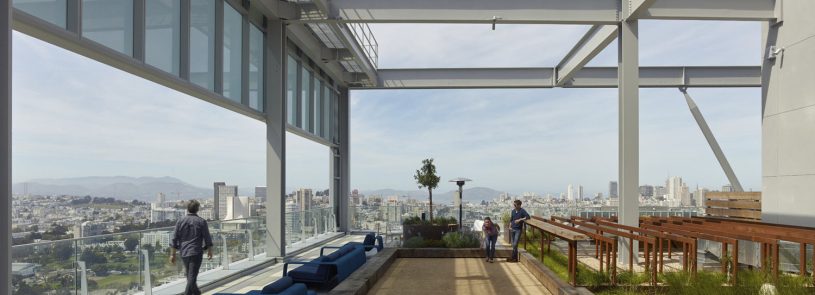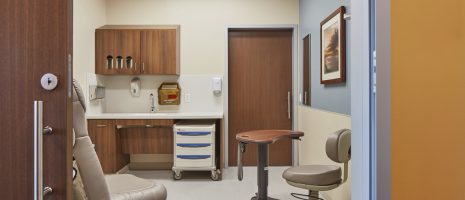Developing an office to residential conversion? Engineering it will bring opportunities and challenges.

By Scott Campagna, PE, Senior Director of Housing
|
Find funding for office-to-residential conversion The White House has released a new plan to accelerate conversions of empty offices into affordable housing units, and to direct developers toward funding sources. The plan comes as second quarter commercial real estate investment volumes have fallen by 64% year-over-year, and office vacancies reached a 30-year high of 18.2%. Meanwhile the market is estimated to need another 3.8 million housing units to meet demand. The new federal guidebook catalogs billions of dollars in financing resources — low-interest loans, loan guarantees, grants, and tax incentives — available to property owners and developers, including the historic Tax Credit, the 45L New Energy Efficient Home Credit, Departments of Energy and Transportation below-market-rate loan programs, and more. It also offers technical assistance to encourage these conversions to be environmentally friendly. In addition, the General Services Administration and the Office of Management and Budget will identify federal properties that could be converted to housing. Read more. Read IMEG’s executive guide about office-to-residential conversions here. |
Freddie Mac estimates the U.S. has a housing deficit of 3.8 million units, across all housing types and post-pandemic office vacancies exceed 16%, with some major cities reaching 31% vacancy rates.
With this occurring in our communities, the opportunity to convert vacant or underutilized office space into residential units is being discussed as a way to revitalize communities, help struggling building owners, and address local housing needs. The market is already seeing this trend. According to RentCafe’s annual Adaptive Reuse Report, currently there are over 45,000 apartment units being created as a result of these office conversations.
Some cities, including Boston and San Francisco, have begun encouraging these conversions by supporting financial incentives, changing zoning policies and finding ways to expedite plan reviews.
Each building is unique, and some are better suited to conversion than others. A thorough review of its basic infrastructure and systems early on can help ensure a successful project. This blog outlines some of the mechanical, electrical, plumbing, fire alarm, and fire protection issues that could add significant costs to a project if they are overlooked in the early stages.
Utilities
Multifamily housing will make greater demands on the plumbing utility than an office.
- The sanitary and domestic water services, including the water meter, will need to be upgraded or replaced, and you must ensure the site sewer has adequate capacity to handle the increased demand.
- The fire protection and electrical utility sizes are typically adequate to support a living facility.
Metering

Who pays for power and water usage? That’s a big decision for a developer, and one that’s often based on market analysis. In a conversion:
- Water usage can typically be easily sub-metered, so the resident pays the utility company directly.
- If you use the existing electrical and HVAC systems, individually metering the power usage may be difficult. Office owners may have structured leases to pass utility costs onto the tenant. If not, individually metering each living unit may be difficult unless you change the power distribution system.
- If you intend to meter each unit separately, you will have significantly more meters than in an office tenant environment. You will need to find space for this equipment.
- If it is not feasible to individually meter power, water and/or HVAC usage, the costs will be built into the rent. If you are in a market where tenants pay for their own power, your asking price with power included will likely be above the market rate. Be sure to communicate the benefit of these higher rents to potential tenants.
- Many states and utility providers will not allow you to sub-meter power and charge back the tenant. If they do, you may need to prove your system is more efficient and offers a benefit to the end user before you can sub-meter and “sell” power.
HVAC
 Each residential unit needs its own thermostat for HVAC control. This is typically accomplished with localized HVAC equipment. But in office buildings, HVAC systems are usually centralized, with large rooftop units and shared air handlers.
Each residential unit needs its own thermostat for HVAC control. This is typically accomplished with localized HVAC equipment. But in office buildings, HVAC systems are usually centralized, with large rooftop units and shared air handlers.
- The existing HVAC system may need to be updated or replaced to provide localized HVAC controls to the tenant.
- HVAC systems for offices buildings are sized to handle large loads for a set amount of time, say from 8 a.m. to 5 p.m. Apartment HVAC systems are sized for an average usage over a season or year. The load on an existing HVAC office system may not translate well to residential.
- Office HVAC systems tend to be more efficient. If it can be reused, that offers opportunities to improve energy efficiency in the building.
- If you can provide localized tenant control from a central HVAC system, you will need to decide if you will sub-meter those costs or include them in the rent.
- Keep in mind, if a central-based HVAC system on a floor goes out, every tenant on that floor will lose HVAC.
- Outside air ventilation differs for commercial and residential — each residential unit will need outside air ventilation, either natural or mechanical. You may need new infrastructure to support the switch.
- Evaluate the available roof and ground area. Is there enough room to accommodate a new HVAC system? A single-split system heat pump condensing unit needs a 3-feet by 3-feet of space, per unit.
Electrical
Office environments have plenty of electrical power, but it’s distributed differently than a residential property.
- Plan to remove power back to the main distribution rooms for a living unit.
- If the office building has 460 volts, all residential units will need to be converted to 208 volts, which may require additional transformers (and finding space for this equipment.)
- Electrical panels need to be in each unit.
- Office lighting will be removed. Can lights, ceiling fan light kits, and decorative kitchen sconces will be added to each unit.
- Multifamily residential will require more EV chargers than an office building. How that power is routed within the building could have implications on the site or parking garage.
Fire Alarm
Residential buildings need far more fire alarm devices. The office’s existing fire alarm system and panel may need to be upgraded or expanded to accommodate these new devices.
- A typical 1 bed/1 bath unit will have six to eight fire alarm devices.
- Dwelling units require carbon monoxide detection when gas-fired heating, cooking, or ambiance equipment is applicable.
Plumbing
 An office has significantly fewer plumbing demands than a multifamily residential building. Most of the internal sanitary system, particularly under slab, will need to be replaced to accommodate the higher demand.
An office has significantly fewer plumbing demands than a multifamily residential building. Most of the internal sanitary system, particularly under slab, will need to be replaced to accommodate the higher demand. - Typical offices have core restrooms and then miscellaneous fixtures out in the spaces. Therefore, there are limited plumbing penetrations in the floors.
- For a typical 1 bed/1 bath unit, you will need 8 to 10 floor penetrations to accommodate the plumbing fixtures, sanitary stacks, and vent stacks. This could have a negative impact on the structure. A structural evaluation will be required.
- If you have a post tension (PT) floor plate, it become even more difficult as all fixtures and new holes in the floor need to be routed around the PT tendons. This can make it difficult to have typical unit types as the fixtures may need to be in different locations from unit to unit based on location of PT tendons.
- The cold-water supply system will need to be replaced. The water demand in a living facility is significantly higher than in an office.
- If there is an existing domestic booster pump, it will need to be replaced to accommodate the higher demand load.
- Even if you do not need a domestic booster pump initially, consideration should be made to prep for one if it is needed in the future.
Fire Protection
- You will need to add sprinkler heads and piping to the existing system.
- For an average 1,000-sf living unit, you may need eight to 10 sprinkler heads. The same size space in an open office environment would need four or five sprinkler heads.
- If there is an existing fire pump, it should be adequately sized to handle a living facility.
- If hose pull allowances are exceeded in the new floor plan layout, new hose valves and a supply pipe may be needed on each floor.
Life Safety
- High-rise office buildings will have stairwell, elevator, and corridor pressurization. When the layout is reconfigured for residential, those emergency systems will be impacted and may need to be modified.
- Generators that support emergency systems will need to be evaluated. The upgrades and changes to the emergency systems may require a new generator.
- New fire walls may be needed in the living facility arrangement, particularly across a corridor. This could impact how electrical distribution occurs.
Check out some of IMEG’s office to residential conversions:
- 100 Van Ness – 29-story office building converted to luxury apartments in San Francisco. Watch an ABC7news.com report about this project.
- 220 North Meridian — A 20-story office building converted into a mixed-use residential high-rise in Indianapolis, IN.
- Sixteen Hundred Lofts — A six-story former factory and U.S. Citizenship and Immigration Services office converted into upscale apartments in Philadelphia.
- 2040 Market — The five-story concrete former headquarters for the American Automobile Association (AAA) in Philadelphia was renovated, with vertical and horizontal expansion, into a mixed-use residential building.
- The Beacon — The residential conversion of a six-story historic office building in Philadelphia, with six-story overbuild and new 14-story addition.
- David Whitney Building – 20-story historic office building converted to hotel and residential in Detroit.
- Detroit Savings Bank Building – 12-story historic office building converted to luxury apartments in Detroit.
- Capitol Park Building – 11-story historic office building converted to luxury apartments in Detroit.
- Locust Walk at Washington Square — A five-story historic office building converted to condominiums in Philadelphia.
- Two Ruan — A 14-story office building being converted to market-rate apartments in Des Moines. Expected to open in 2025.
- Victory Center — An 11-story office building being converted to 400 apartments in Alexandria, VA. Expected to open in 2025.
- The Victor — A former warehouse converted to 300 apartments in St. Louis. Expected to open in 2023.
For information about the structural engineering opportunities and challenges in office to residential conversions, check out these IMEG blogs.)








 An office has significantly fewer plumbing demands than a multifamily residential building. Most of the internal sanitary system, particularly under slab, will need to be replaced to accommodate the higher demand.
An office has significantly fewer plumbing demands than a multifamily residential building. Most of the internal sanitary system, particularly under slab, will need to be replaced to accommodate the higher demand. 



